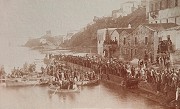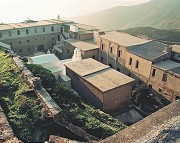 The island is commonly believed to have been named after General Andros, as a reward for his services to the Cretan King Radamanthys. But it also appeared under other names, such as Hydroussa, Lassia and Gavros. Recent excavations conducted by the archaeologist Dr. Christina Televantou on the Strofila plateau (Stavropeda area) brought to light a settlement dating back to the late Neolithic period (4500-3200 B.C.)
The island is commonly believed to have been named after General Andros, as a reward for his services to the Cretan King Radamanthys. But it also appeared under other names, such as Hydroussa, Lassia and Gavros. Recent excavations conducted by the archaeologist Dr. Christina Televantou on the Strofila plateau (Stavropeda area) brought to light a settlement dating back to the late Neolithic period (4500-3200 B.C.)
 The settlement is considered of significant importance and is one of the best preserved of that period throughout the Aegean. Finds include walls and remains of buildings with spacious interiors. The frescoes on the walls mainly represent boats and scenes including wild animals and birds. Further finds going back to the Bronze Age (Geometric era) were found in the areas of Plaka (20th – 18th B.C.), Zagora and Ypsili.
The settlement is considered of significant importance and is one of the best preserved of that period throughout the Aegean. Finds include walls and remains of buildings with spacious interiors. The frescoes on the walls mainly represent boats and scenes including wild animals and birds. Further finds going back to the Bronze Age (Geometric era) were found in the areas of Plaka (20th – 18th B.C.), Zagora and Ypsili.
On the archaeological site of the Zagora peninsula (Stavropeda area), a Geometric settlement (10th – 8th century B.C.) was unearthed. Findings from this site, including pottery ware, tools, jewellery, religious artifacts, remains of a temple and of a residence can all be seen at the Chora’s Archaeological Museum.
 Excavations are still ongoing at the Geometric settlement of Ypsili-Aprovatos, at Palaeopolis and at the Chora’s medieval castle. In the 7th century B.C., Andros took part in the colonization of Chalkidiki, where it established three settlements (Akanthos, Sani and Stagira) and founded the city of Argilos. During the Persian wars, Andriots were subdued to the Persians until the defeat of the Persian fleet in Salamis. In the Classical age, the island – with Palaeopolis as a capital – enjoyed a period of prosperity, as suggests the city’s coinage from this time.
Excavations are still ongoing at the Geometric settlement of Ypsili-Aprovatos, at Palaeopolis and at the Chora’s medieval castle. In the 7th century B.C., Andros took part in the colonization of Chalkidiki, where it established three settlements (Akanthos, Sani and Stagira) and founded the city of Argilos. During the Persian wars, Andriots were subdued to the Persians until the defeat of the Persian fleet in Salamis. In the Classical age, the island – with Palaeopolis as a capital – enjoyed a period of prosperity, as suggests the city’s coinage from this time.
 In the 11th – 12th century AD, Andros grew prosperous; it became famous in the West for its silk production, while merchant shipping developed on the island. Numerous churches of remarkable architecture date back to this part of the Byzantine era, such as Taxiarchis (Archangels) churches in Ypsilou, Melidia and Messaria, the Church of the Dormition of the Mother of God in Messathouri, the Monastery of Zoodochos Pigi (14th century), that of St. Nicolas (built in 1560 and restored in the 18th century), the Panachrantos Monastery (also Monastery of St. Panteleimon) which was built in 1662, and St. Marina’s Monasteri.
In the 11th – 12th century AD, Andros grew prosperous; it became famous in the West for its silk production, while merchant shipping developed on the island. Numerous churches of remarkable architecture date back to this part of the Byzantine era, such as Taxiarchis (Archangels) churches in Ypsilou, Melidia and Messaria, the Church of the Dormition of the Mother of God in Messathouri, the Monastery of Zoodochos Pigi (14th century), that of St. Nicolas (built in 1560 and restored in the 18th century), the Panachrantos Monastery (also Monastery of St. Panteleimon) which was built in 1662, and St. Marina’s Monasteri.
Another cornerstone in the history of Andros is May 10th, 1821, when Theofilos Kairis raised the flag of independence on the island. Andros’ economic growth over the past century owes much to the development of merchant shipping. By 1939, it ranked second after Piraeus in terms of registered ships. While at the turn of 20th century, the Andriot Dimitris Moraitis launched a direct shipping and passenger line between Greece and North America. Through their support and contributions, ship-owners such as the Embirikos, Kambanis, Goulandris, Maris, Kydoniefs and other families played a key role in the islands economic and social development.
But World War II caused great losses in human lives and ships. After the war, the island’s population shrank dramatically as a result of mass migration to the suburbs of Athens and Piraeus.
Today, increasing national and international tourism has led to a steady and coherent development on the island.